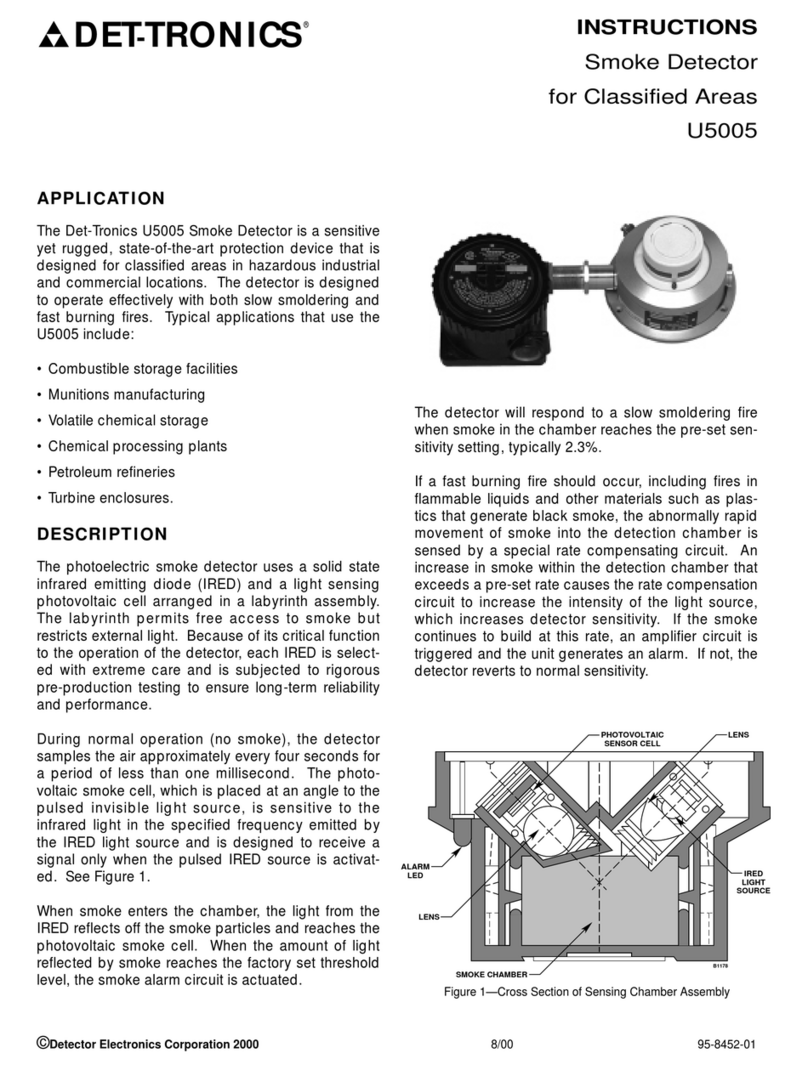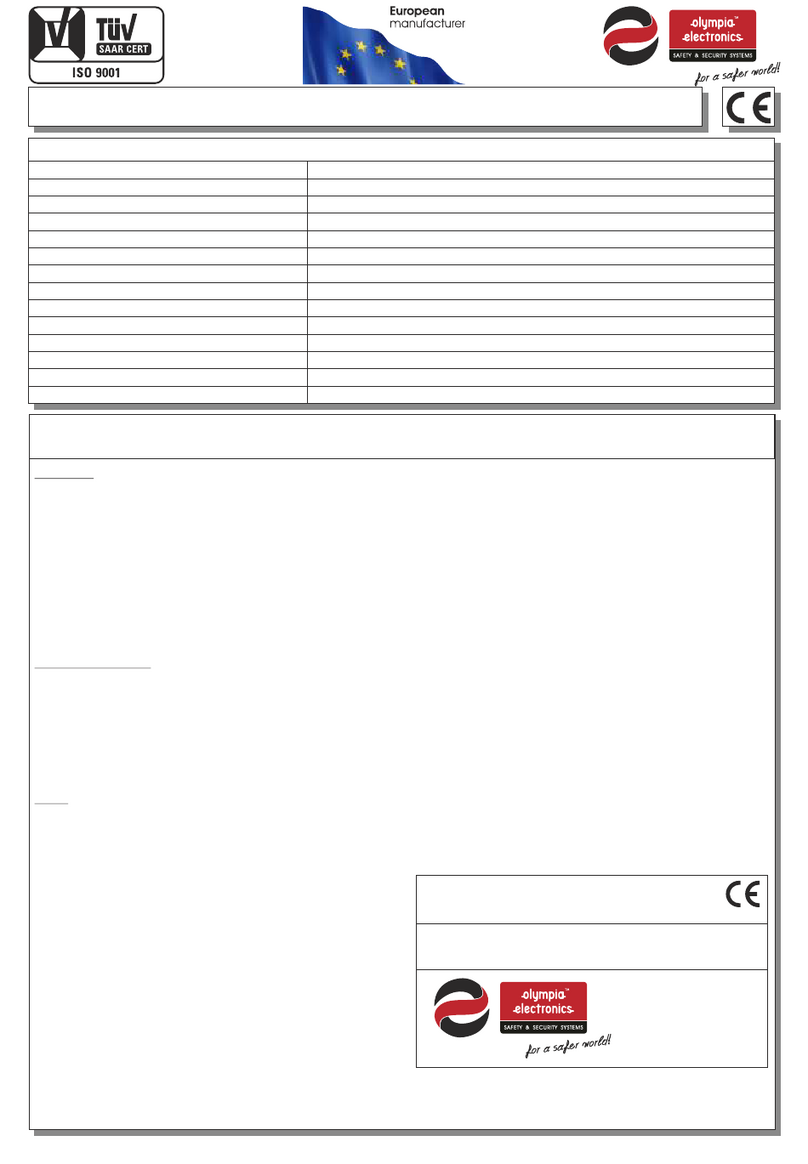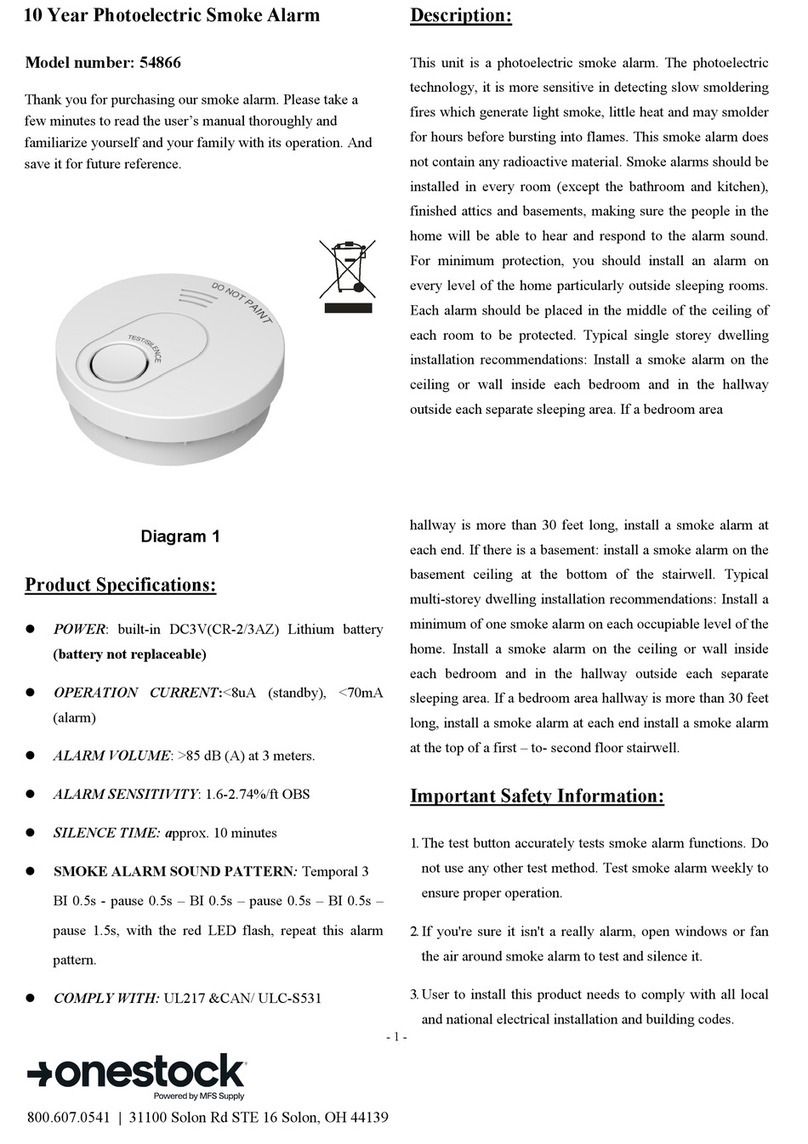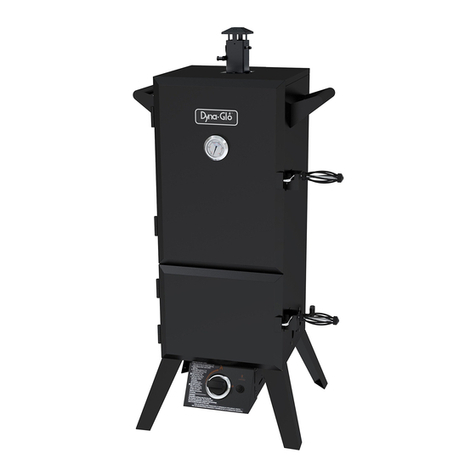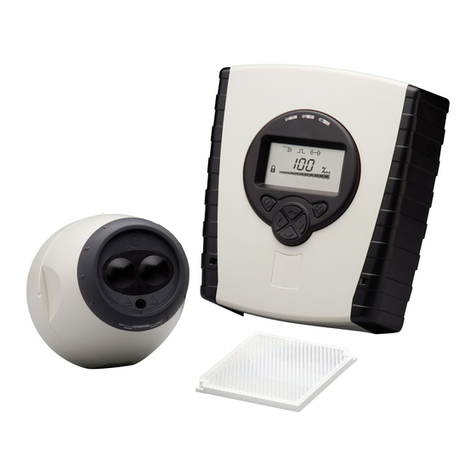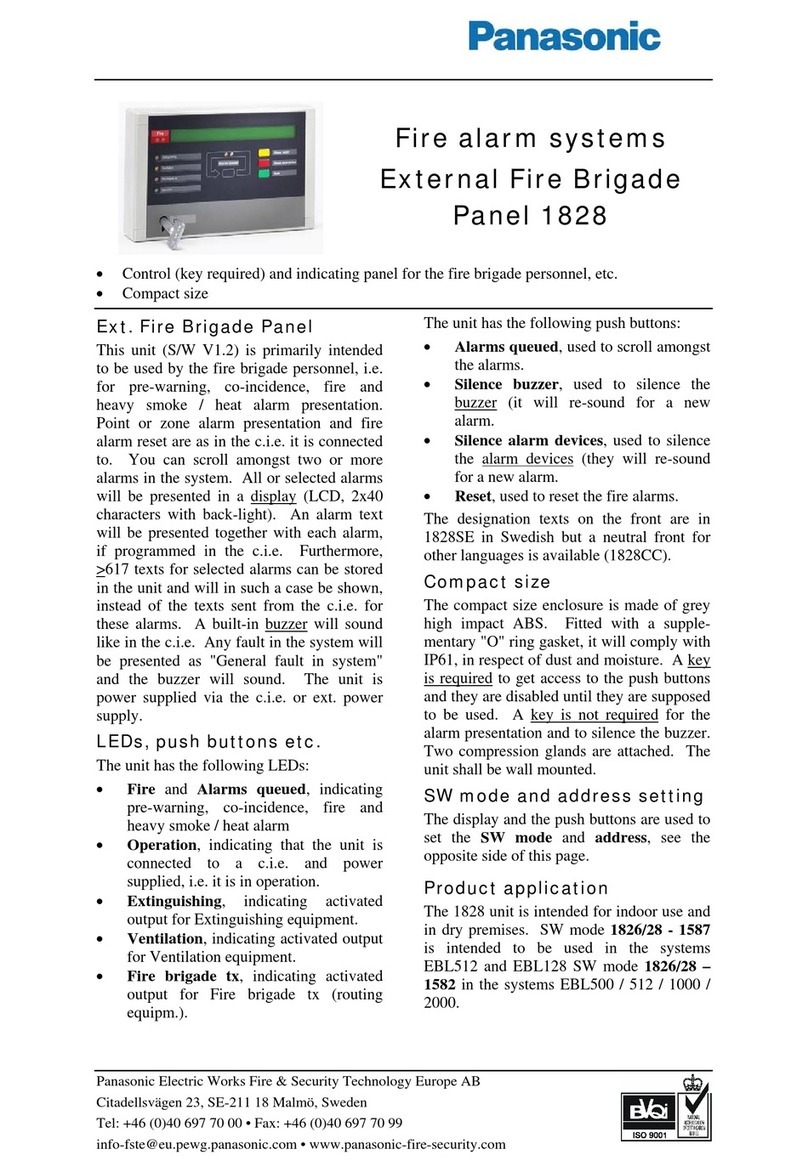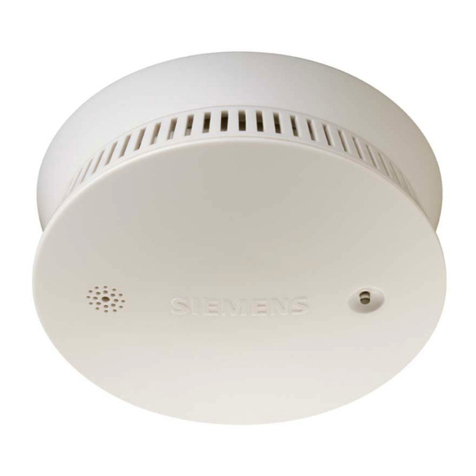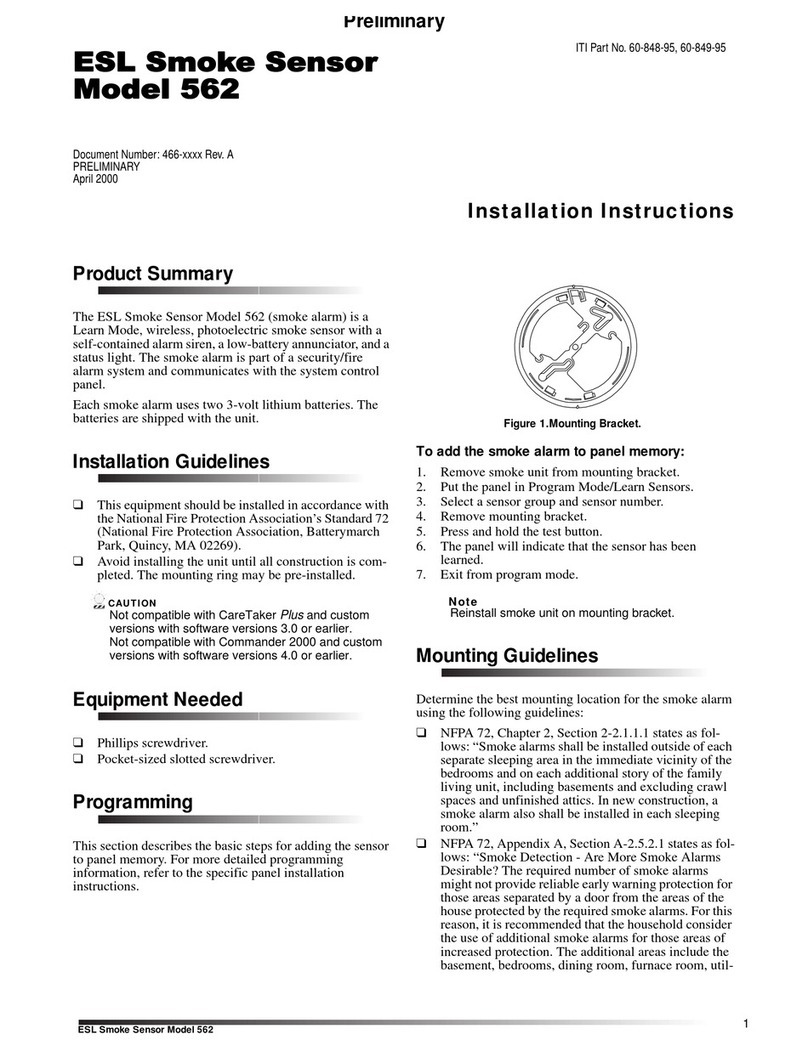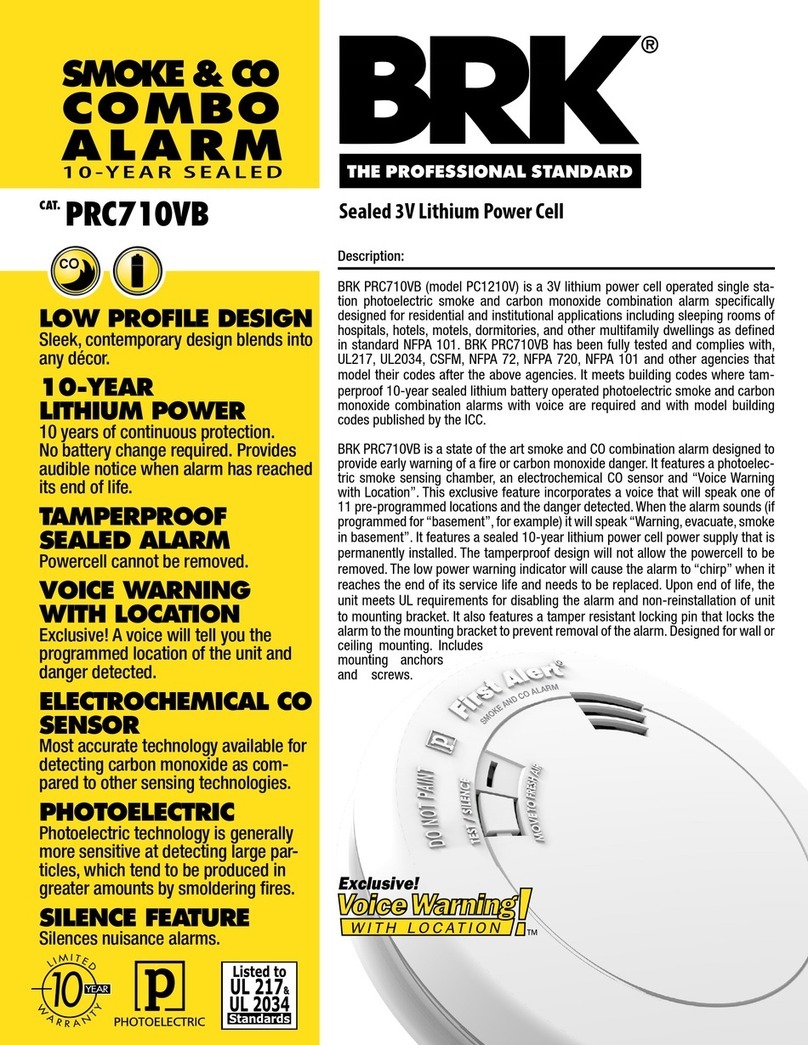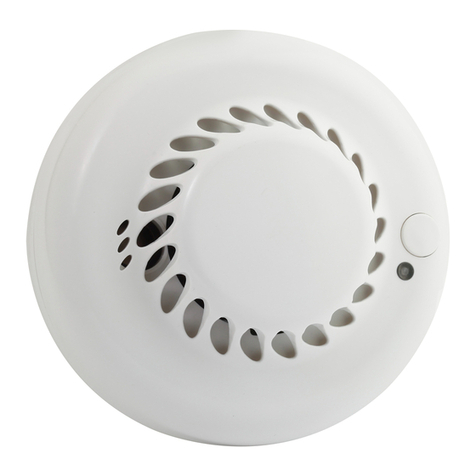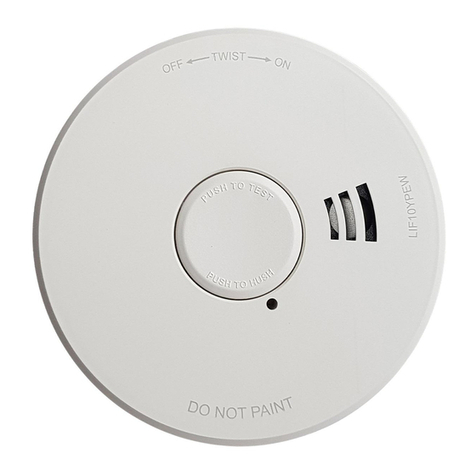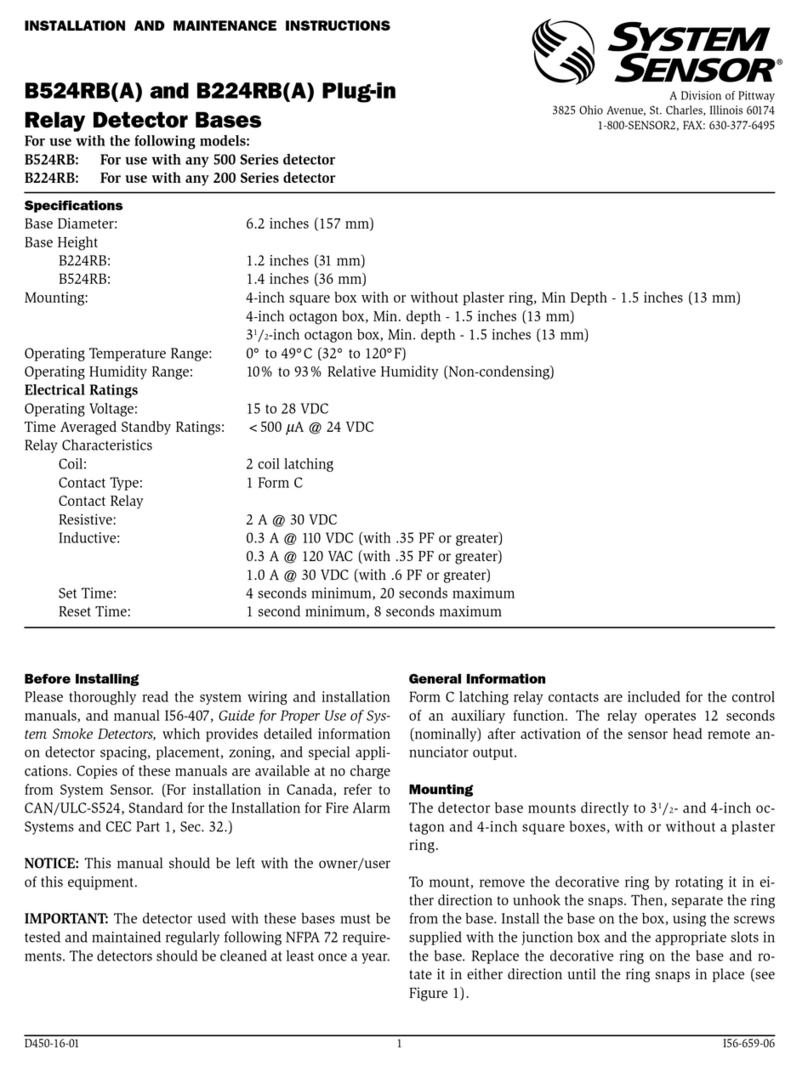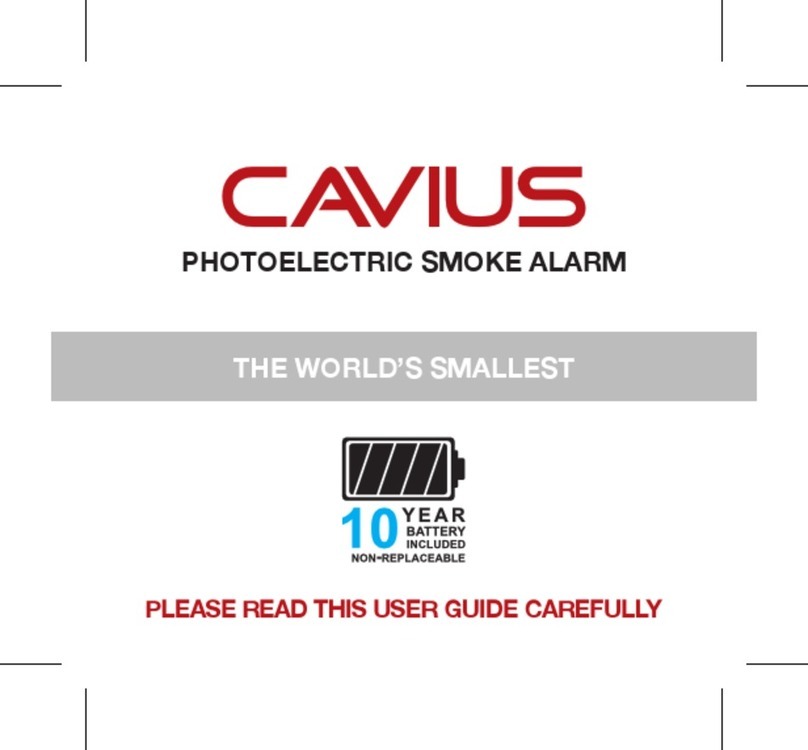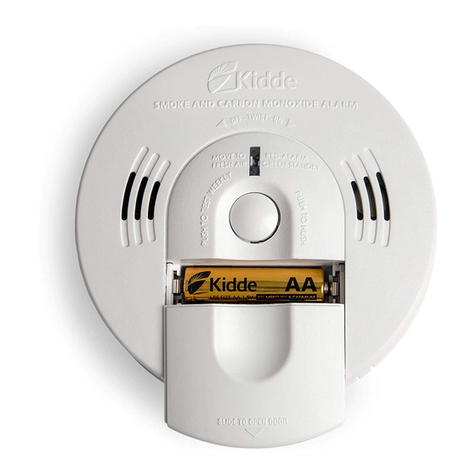Det-Tronics X3300 User manual

Instructions 95-8502
Protect•ir Multispectrum IR Flame Detector
X3300
Detector Electronics Corporation
6901 West 110th Street •Minneapolis, Minnesota 55438 USA
Tel: 952.941.5665 or 800.765.3473 •Fax: 952.829.8750 9/00 95-8502

IMPORTANT
Be sure to read and understand the entire
instruction manual before installing or operating the
flame detection system.
WARNING
Do not open the detector assembly in a hazardous
area when power is applied. The detector contains
no user serviceable components and should never
be opened. Doing so could disturb critical optical
alignment and calibration parameters, possibly
causing serious damage. This type of damage
could be undetected and could result in failure to
see a fire and/or false alarm.
CAUTION
The wiring procedures in this manual are intended
to ensure proper functioning of the device under
normal conditions. However, because of the many
variations in wiring codes and regulations, total
compliance to these ordinances cannot be
guaranteed. Be certain that all wiring complies
with the NEC as well as all local ordinances. If in
doubt, consult the authority having jurisdiction
before wiring the system. Installation must be
done by a properly trained person.
CAUTION
To prevent unwanted actuation or alarm,
extinguishing devices must be disconnected prior
to performing detection system tests or
maintenance.
ATTENTION
Remove protective cap from front of the detector
before activating the system.
ATTENTION
Observe precautions for handling electrostatic
sensitive devices.
ATTENTION
The X3300 includes the Automatic Optical Integrity
(oi) feature — a calibrated performance test that is
automatically performed once per minute to verify
complete detector operation capabilities. No
testing with an external test lamp is required.
DESCRIPTION
The X3300 Protect•ir is a multispectrum infrared (IR)
flame detector. It provides unsurpassed detection of
fires from light to heavy hydrocarbon fuels combined
with the highest degree of false alarm rejection. The
detector is suitable for use in indoor and outdoor
applications with NEMA 4X/IP66 classifications as well
as EExd/EExe explosion-proof ratings.
The X3300 contains three IR sensors, signal processing
circuitry, and fire and fault relays. A tricolor LED on the
detector faceplate indicates normal, fire alarm, and fault
conditions.
Protect•ir
Multispectrum IR Flame Detector
X3300
©Detector Electronics Corporation 2000 9/00 95-8502
DET-TRONICS®
*oiis Detector Electronics' Trademark for its patented Optical
Integrity Systems, U.S. Patent 3,952,196, United Kingdom Patent
1,534,969, Canada Patent 1,059,598.
INSTRUCTIONS

Factory configurable options include:
• Automatic or Manual Optical Integrity (oi)
• Fire and Fault Relay Operation
– Normally Open (N.O.) or Normally Closed (N.C.)
Contacts
– Normally Energized or Normally De-Energized (Fire
relay)
– Latching or Non-latching.
• 4 to 20 mA output.
Table 2—Factory Configuration Options (Not Changeable in the Field)
Option Available Configurations
Sensitivity • Detects 1 square foot gasoline fire at 210 feet (very high
sensitivity) or 100 feet (medium sensitivity).
Optical Integrity (oi)*Automatic oi- Automatically checks internal circuitry and
cleanliness of viewing windows to ensure proper operation.
If a fault condition exists, the amber Fault LED lights.
• Manual oi- Cleanliness of viewing windows test can be
manually initiated by closing an external switch that is elec-
trically connected between the oilead and circuit ground.
Warning: Successful Manual oitest results in fire alarm
relay activation and red Alarm LED lights.
• Internal circuitry is automatically tested independent of the
Manual oitest
Fire Relay Latching/Non-Latching • Latching - Relay remains in “Fire” condition after fire has
been detected until X3300 power is cycled.
*Non-latching - Relay remains in “Fire” condition only as long
as a fire is being detected.
Normally Energized/De-Energized • Normally Energized - Fire relay is energized in non-alarm
(no fire) condition.
*Normally De-Energized - Fire relay is de-energized in non-
alarm (no fire) condition.
Contacts Normally Open/Closed *Normally Open - Fire relay contacts are open in non-alarm
(no fire) condition.
• Normally Closed - Fire relay contacts are closed in non-
alarm (no fire) condition.
Fault Relay Latching/Non-Latching • Latching - Relay remains in “Fault” condition after fault has
been detected until X3300 power is cycled.
*Non-latching - Relay remains in “Fault” condition only as
long as a fault is being detected.
Normally Energized *Normally Energized - Fault relay is energized with no fault
present.
Contacts Normally Open/Closed *Normally Open - Fault relay contacts are open when fault is
present.
• Normally Closed - Fault relay contacts are closed when
fault is present.
4 to 20 mA Output • Current output level indicates detector status condition.
* Standard Configuration
2
Detector Status LED Indicator
Power On/Normal Operation Green
(no fault or fire alarm)
Fault Yellow
Fire (Alarm) Red
Medium Sensitivity Two Yellow Flashes
During Power-up
Very High Sensitivity Four Yellow Flashes
During Power-up
Table 1—Detector Status Indicator

Refer to the “Ordering Information“ section for a
complete list of available options and accessories.
Table 1 indicates the condition of the LED for each
detector status. The LED is non-latching. Fire and Fault
relay condition for each detector status varies
according to the factory configuration.
FACTORY CONFIGURATION OPTIONS
The X3300 is configured at the factory to operate as
specified when ordered. Refer to the descriptions in
Table 2 for a functional explanation of each
configuration option.
NOTE
Factory configurable options cannot be changed in
the field.
4 TO 20 MA OUTPUT
This option provides a 4 to 20 mA dc current output for
transmitting detector status information to other devices.
The circuit can be wired in either an isolated or non-
isolated configuration and can drive a maximum loop
resistance of 500 ohms from 18 to 19.9 volts dc and 600
ohms from 20 to 32 volts dc. Table 3 indicates the
detector status conditions represented by the various
current levels. The output is calibrated at the factory,
with no need for field calibration.
NOTE
The output of the 4 to 20 mA current loop is not
monitored by the fault detection circuitry of the
X3300. Therefore, an open circuit on the loop will
not cause the detector status LED to indicate a
fault.
GENERAL APPLICATION
INFORMATION
RESPONSE CHARACTERISTICS
Response is dependent on the type of fuel, the
temperature of the fuel, and the time required for the fire
to come to equilibrium. As with all fire tests, results
must be interpreted according to an individual
application.
See Appendix A for fire test results.
IMPORTANT APPLICATION CONSIDERATIONS
In applying any type of sensing device as a fire
detector, it is important to know of any conditions that
can prevent the device from responding to fire, and also
to know what other sources besides fire can cause the
device to respond.
Welding
Arc welding should not be performed within 40 feet of
the long range detector (10 feet for medium range
detector). It is recommended that the system be
bypassed during welding operations in situations where
the possibility of a false alarm cannot be tolerated. Gas
welding mandates system bypass, since the gas torch
is an actual fire. Arc welding rods can contain organic
binder materials in the flux that burn during the welding
operation and are detectable by the X3300. Welding
rods with clay binders do not burn and will not be
detected by the X3300.
Artificial Lighting
The X3300 should not be located within 3 feet of
artificial lights. Artificial lights should not be positioned
so that they are pointed directly at the detector.
EMI/RFI Interference
The X3300 is resistant to interference by EMI and RFI. It
will not respond to a 5 watt walkie-talkie at distances
greater than 1 foot. Do not operate a walkie-talkie within
1 foot of the X3300.
Non-Carbon Fires
The X3300 is a multiple spectrum IR device with
detection limited to carbonaceous fuels. It should not
be used to detect fires that do not contain carbon, such
as hydrogen, sulfur and burning metals.
3 95-8502
Current Level Detector Status
0 mA Open Circuit
1 mA General Fault
2 mA Oi Fault
3 mA Hi Background IR
4 mA Normal Operation
20 mA Alarm
Table 3—Detector Status Conditions Indicated by Current Level

INSTALLATION
DETECTOR POSITIONING
Detectors should be positioned to provide the best
unobstructed view of the area to be protected. The
following factors should also be taken into consideration:
• Identify all high risk fire ignition sources.
• Be sure that enough detectors are used to adequately
cover the hazardous area.
• Locate and position the detector so that the fire
hazard(s) are within both the field of view and
detection range of the device. Refer to Appendix A
for specific information.
• Be sure that the unit is easily accessible for cleaning
and other periodic servicing.
• For outdoor applications, the detector should be
aimed downward at least 10 to 20 degrees to allow
lens openings to drain. See Figure 1.
• For best performance, the detector should be
mounted on a rigid surface in a low vibration area.
• Dense fog, rain or ice can absorb IR radiation and
reduce the sensitivity of the detector.
• Although IR detectors are less affected by smoke than
other detectors, the X3300 should not be placed
where rising combustion products can obscure its
vision. If smoke is expected before fire, smoke or
other alternative detectors should be used in
conjunction with the X3300. For indoor applications, if
dense smoke is expected to accumulate at the onset
of a fire, mount the detector on a side wall at least a
few feet (approximately 1 meter) down from the
ceiling.
• If possible, fire tests should be conducted to verify
correct detector positioning and coverage.
WIRING REQUIREMENTS
WIRE SIZE AND TYPE
The system should be wired using a 14 to 22 gauge (1.3
to 0.5 mm2) cable. The wire size selected should be
based on the number of detectors connected, the
supply voltage and the cable length. A minimum input
voltage of 18 vdc must be present at the X3300.
The use of shielded cable is recommended to protect
against interference caused by EMI and RFI. When
using cables with shields, terminate the shields as
shown in Figures 6 through 8.
In applications where the wiring cable is installed in
conduit, the conduit should not be used for wiring to
other electrical equipment.
CAUTION
Installation of the detector and wiring should be
performed only by qualified personnel.
PROTECTION AGAINST MOISTURE DAMAGE
It is important to take proper precautions during
installation to ensure that moisture will not come in
contact with the electrical connections or components
of the system. The wiring pigtail for the X3300 is factory
sealed for easy installation onto a junction box where
electrical connections are made. The integrity of the
system regarding moisture protection must be
maintained for proper operation and is the responsibility
of the installer.
If conduit is used, drains must be installed at water
collection points to automatically drain accumulated
moisture. Conduit breathers should be installed at
upper locations to provide ventilation and allow water
vapor to escape. At least one breather should be used
with each drain.
4
Figure 1—Detector Orientation Relative to Horizon
CENTER AXIS
OF DETECTOR
FIELD OFVIEW
CENTER AXIS
OF DETECTOR
FIELD OFVIEW
INCORRECT
CORRECT
NOTE: DETECTOR MUST ALWAYS BE AIMED
DOWNWARD AT LEAST 10 TO 20 DEGREES.
B1974

Conduit raceways should be inclined so that water will
flow to low points for drainage and will not collect inside
enclosures or on conduit seals. If this is not possible,
install conduit drains above the seals to prevent the
collection of water or install a drain loop below the
detector with a conduit drain at the lowest point of the
loop.
The detector is factory sealed. Conduit seals are not
required for compliance with explosion-proof installation
requirements.
MOUNTING AND WIRING PROCEDURE
Refer to the procedure below and the listed figures to
mount and wire the X3300.
Figure 1 – Detector Orientation Relative to Horizon
Figure 2 – Wiring Terminal Identification
Figure 3 – X3300 with Q9003 Swivel Mount
Figure 4 – Front View of the X3300
Figure 5 – X3300 Terminal Block
Figure 6 – A Typical System
Figure 7 – X3300 Detector with 4 to 20 mA Output
oi PLATE ORIENTATION
Refer to Figure 4 and insure that the oi plate will be
oriented as shown when the X3300 is mounted and
sighted. This will ensure proper operation of the oi
system and will also minimize the accumulation of
moisture and contaminants between the oi plate and
the viewing windows. The oi plate includes an arrow,
which should be pointed in the up direction, indicating
that the oi plate and detector are correctly oriented.
IMPORTANT
The oi plate must be securely tightened to ensure
proper operation of the oi system.
INSTALLATION USING Q9003 MOUNTING
BRACKET
1. Install the swivel mounting bracket assembly on the
wall or ceiling. The installation surface should be
free of vibration. Refer to Figure 8 for dimensions of
the Q9003 swivel mount.
2. Make field connections following local ordinances
and guidelines in this manual. Refer to Figures 2
and 6. If the detector is equipped with 4 to 20 mA
output, refer to Figure 7.
NOTE
Connect the shield to power supply minus (circuit
ground) at the detector end. At the fire panel end,
connect the shield and power supply minus to
chassis ground through a 0.47 µF 400 Volt non-
polarized capacitor (not supplied).
3. Check all field wiring to be sure that the proper
connections have been made.
IMPORTANT
Do not test any wiring connected to the detector
with a meg-ohmmeter. Disconnect wiring at the
detector before checking system wiring for
continuity.
4. Make the final sighting adjustments and ensure that
the mounting bracket hardware is tight.
5 95-8502
COLOR FUNCTION
RELAY 4TO 20 MA
WHITE
BLACK
RED
COLOR
WHITE
BLACK
RED
GRAY
PURPLE
BROWN
BLUE
GREEN GREEN
MANUAL Oi
DC –
DC+
FUNCTION
MANUAL Oi
DC –
DC+
FAULT NO
FAULT C
FIRE NO
FIRE C
CHASSIS CHASSIS
WHT/BRN
WHT/RED
4TO 20 (–)
4TO 20 (+)
A1977
1
2
3
4
5
6
7
8
TERMI-
NAL #
Figure 2—Wiring Terminal Identification
Figure 3—X3300 with Q9003 Mounting Bracket

6
Oi ARROW
(MUST BE ORIENTEDWITH ARROW POINTING UP)
VIEWINGWINDOW (3)
Oi PLATE KNOB
Oi PLATE
DETECTOR STATUS INDICATOR
A1984
Figure 4—Front View of the X3300 Detector/Controller
Figure 5—X3300 Terminal Block

7 95-8502
X3300
B1978
FIRE ALARM PANEL
ALARM
24 VDC
+
–
oi
–
+
FAULT RELAY 1
ALARM RELAY 2
WIRING NOTES:
1 FAULT RELAYS SHOWN HAVE BEEN SPECIFIED (WHEN ORDERED)
TO HAVE NORMALLY CLOSED CONTACTS
AND TO BE NORMALLY ENERGIZED WITH NO FAULT PRESENT.
2 ALARM RELAYS SHOWN HAVE BEEN SPECIFIED (WHEN ORDERED)
TO HAVE NORMALLY OPEN CONTACTS
AND TO BE NORMALLY DE-ENERGIZED WITH NO ALARM CONDITION PRESENT.
3 INDIVIDUAL MANUAL oiTEST SWITCHES CAN BE INSTALLED REMOTELY
OR A DETECTOR SELECTOR AND ACTIVATION SWITCH CAN BE INSTALLED AT THE FIRE PANEL.
TEST SWITCHES ARE NOT SUPPLIED.
4 END OF LINE DEVICE SUPPLIED BY PANEL.
END OF
LINE DEVICE 4
oi TEST 3
.47 µF/400 V
FILM CAPACITOR
GREEN
COLOR
RELAY 4TO 20 MA
WHITE
BLACK
RED
GRAY
PURPLE
BROWN
BLUE
GREEN
FUNCTION
MANUAL Oi
DC –
DC+
FAULT NO
FAULT C
FIRE NO
FIRE C
CHASSIS
COLOR
WHITE
BLACK
RED
GREEN
WHT/BRN
WHT/RED
FUNCTION
MANUAL Oi
DC –
DC+
CHASSIS
4TO 20 (–)
4TO 20 (+)
(4)
(1)
(2)
(3)
(5)
(6)
(7)
1
2
3
4
5
6
7
8
TERMI-
NAL #
Figure 6—A Typical System

OPTICAL INTEGRITY (oi)
AUTOMATIC oi
The X3300 includes the Automatic Optical Integrity (oi)
feature — a calibrated performance test that is
automatically performed once per minute to verify
complete detector operation capabilities. No testing
with an external test lamp is required. The detector
automatically performs the same test that a
maintenance person with a test lamp would perform —
once every minute, 60 times per hour. A successful
automatic oi test does not produce an alarm condition.
The Protect•ir signals a fault condition when less than
50% of the detection range remains. This is indicated
by the Fault relay and is evident by the amber color of
the LED on the face of the detector. See the
“Troubleshooting” section for further information.
MANUAL oi
The detector also incorporates a manual oi feature that
provides the same test as the automatic oi, and in
addition actuates the Alarm relay to verify output
operation. The manual oi feature is available in all
models and can be performed at any time. This test
requires bypass of all extinguishing devices to avoid
release resulting from a successful test.
The manual oi test is activated by connecting the white
lead to power supply minus. This places the detector in
a special operating mode. First, the device de-latches
any latching outputs. Next, the IR emitters are activated.
If the resulting signals meet the test criteria, the Alarm
relay changes state and the indicating LED changes to
red. This condition remains until the white lead is
disconnected from dc minus. If the test criteria are not
met, no alarm is produced and no fault is generated.
See the “Troubleshooting” section for further details.
STARTUP PROCEDURE
When installation of the equipment is complete, perform
the “Fire Alarm Test” below.
Allow 20 to 30 minutes for the detector optics to reach
equilibrium. Housing will be warm to the touch.
8
24 VDC
4 TO 20 MA
PLC
–
+
875 MAX
AT 24 VDC
–
–
4 TO 20
MA
Oi
–24 VDC
+24 VDC
1
2
3
4
5+
+
A2005
Figure 7A—X3300 Detector Wired for Non-Isolated 4 to 20 ma
Current Output (Sourcing)
24 VDC
4 TO 20 MA
PLC
–
+
875 MAX
AT 24 VDC –
–
4 TO 20
MA
Oi
–24 VDC
+24 VDC
1
2
3
4
5+
+
A2006
Figure 7B—X3300 Detector Wired for Non-Isolated 4 to 20 ma
Current Output (Sinking)
24 VDC
4 TO 20 MA
PLC
–+
24 VDC
–
+
875 MAX
AT 24 VDC
–
–
4 TO 20
MA
Oi
–24 VDC
+24 VDC
1
2
3
4
5+
+
A2007
Figure 7C—X3300 Detector Wired for Isolated 4 to 20 ma
Current Output (Sourcing)
24 VDC
4 TO 20 MA
PLC
–+
24 VDC
–
+
875 MAX
AT 24 VDC
–
–
4 TO 20
MA
Oi
–24 VDC
+24 VDC
1
2
3
4
5+
+
2008A
Figure 7D—X3300 Detector Wired for Isolated 4 to 20 ma
Current Output (Sinking)

FIRE ALARM TEST
1. Disable any extinguishing equipment that is
connected to the system.
2. Apply input power to the system.
3. Connect the oi test line to dc minus for 5 to 10
seconds or perform a pan fire test. The alarm relay
will change states and the red alarm LED will
illuminate when the device goes into an alarm
condition.
4. Disengage the oi test line or extinguish the test fire.
If the Alarm relay is configured for the standard
non-latching operation, it will change states and the
red LED will turn off. If the unit has latching relays,
they can be reset by removing input power (0.1
second minimum).
5. Repeat this test for all detectors in the system. If a
unit fails the test, refer to the “Troubleshooting”
section.
6. Verify that all detectors in the system are properly
aimed at the area to be protected.
7. Enable extinguishing equipment when the test is
complete.
TROUBLESHOOTING
WARNING
The detector contains no user serviceable
components and should never be opened.
1. Disable any extinguishing equipment that is
connected to the unit.
2. Inspect the viewing windows for contamination and
clean as necessary. The detector is relatively
insensitive to airborne contaminants, however, thick
deposits of ice, dirt, or oil will reduce sensitivity.
(Refer to the “Maintenance” section for complete
information regarding cleaning of the detector
viewing window.)
3. Check input power to the unit.
4 If the fire system has a logging function, check the
fire panel log for relay status and/or 4 to 20 mA
output information. See Table 4.
5. Turn off the input power to the detector and check
all wiring for continuity. Important: Disconnect
wiring at the detector before checking system
wiring for continuity.
9 95-8502
10.7 INCHES
(27.2 CM)
7.8 INCHES
(19.8 CM)
3.9 INCHES
(9.9 CM)
3.9 INCHES
(9.9 CM)
3.0 INCHES
(7.6 CM)
3.0 INCHES
(7.6 CM)
0.4 INCH DIA.
(1.0 CM)
A1981
Figure 8—
Q9003 Mounting Bracket Dimensions in Inches (CM)

6. If all wiring checks out and cleaning of the oi
plate/window did not correct the fault condition,
check for high levels of background IR radiation by
covering the detector with the factory supplied
cover or aluminum foil. If the fault condition clears
within 6 minutes or less, extreme background IR is
present. Re-adjust the view of the detector away
from the IR source or relocate the detector.
If none of these actions corrects the problem, return the
detector to the factory for repair.
NOTE
Since the entire unit must be returned to the
factory for repair, it is highly recommended that a
complete spare be kept on hand for field
replacement to ensure continuous protection.
PERIODIC CHECKOUT PROCEDURE
Periodic testing is not required when the detector is
configured for automatic optical integrity testing. If the
X3300 is configured for manual oi operation, a
checkout of the system using the oi feature should be
performed on a regularly scheduled basis to ensure that
the system is operating properly. To test the system,
perform the “Fire Alarm Test” as described in the
“Startup Procedure” section of this manual.
MAINTENANCE
IMPORTANT
Periodic flamepath inspections are not
recommended since the product is not intended to
be serviced and provides proper ingress protection
to eliminate potential deterioration of the flamepaths.
WARNING
The detector contains no user serviceable
components and should never be opened.
To maintain maximum sensitivity, the viewing windows
of the X3300 must be kept relatively clean. Refer to the
procedure below for instructions.
CLEANING PROCEDURE
CAUTION
Disable any extinguishing equipment that is
connected to the unit to prevent unwanted
actuation.
To clean the window and oi plate, use Det-Tronics
window cleaner (part number 001680-001) and a soft
cloth or tissue and refer to the procedure below.
1. Disable any extinguishing equipment that is
connected to the unit.
2. Since the X3300 is less affected by contamination
than other detectors, removal of the oi plate is
needed only under extreme conditions. In addition,
it is not necessary to achieve perfect cleanliness,
because IR is not significantly absorbed by slight
films of oil and/or salt. If a fault condition is still
indicated after cleaning, remove and clean the oi
plate using the procedure below.
3. Clean all three viewing windows and reflector
surfaces thoroughly using a clean cloth, cotton
swab or tissue and Det-Tronics window cleaning
solution. If a stronger solution is needed, isopropyl
alcohol may be used.
OiPLATE REMOVAL
1. Remove the oi plate from the detector by loosening
the oi plate knob.
2. Thoroughly clean the oi plate reflective surfaces,
holding it by its edges to avoid leaving fingerprints
on the inside reflective surface.
3. Re-install the oi plate. Ensure that the plate is flat
on the detector surface. Tighten the oi plate knob
securely (40 oz/inches).
NOTE
If the oi plate is removed, be sure to install the
original oi plate. oi plates are not interchangeable
and should not be mixed with oi plates from other
detectors.
NOTE
If corrosive contaminants in the atmosphere cause
the oi plate surface to deteriorate to the extent that
it is no longer possible to restore it to its original
condition, it must be replaced. Consult factory for
oiplate replacement procedure.
10
Current Level Status Action
0 mA Open Circuit Check wiring
connections.
1 mA General Fault Cycle power.
2 mA Oi Fault Clean windows.
3 mA Hi Background IR Remove IR source or
aim detector away
from IR source.
4 mA Normal Operation
20 mA Alarm
Table 4—Troubleshooting Guide

FEATURES
• Long detection range to carbonaceous fires.
• Maximum false alarm rejection capability.
• Maintains the capability to respond to a fire in the
presence of modulated blackbody radiation without
false alarm.
• Heated optics for increased resistance to moisture
and ice.
• Factory sealed device eliminates need for explosion-
proof conduit seal.
• One-hand oi plate removal for easy maintenance even
in the most difficult locations.
• Automatic and manual optical integrity (oi) testing.
• Fire and fault relays standard.
• Tricolor LED indicates normal operation, fire and fault
conditions.
• Factory available fire and fault relay operation:
latching/non-latching, energized/de-energized (fire
relay only), normally open/normally closed.
• 4 to 20 mA isolated output.
• Other mounting options include mounting directly onto
most junction boxes using a simple adapter, or the
use of a swivel union or swivel mount available from
Det-Tronics.
• Operates under adverse weather conditions and in
dirty environments.
• Flame-proof/increased safety detector housing.
Meets CENELEC and DNV certification requirements.
• Class A wiring per NFPA-72.
• Meets NFPA-33 response requirement for under 0.5
second (available when option selected).
• 5 year warranty.
SPECIFICATIONS
OPERATING VOLTAGE—
24 volts dc nominal (18 vdc minimum, 32 vdc
maximum).
POWER CONSUMPTION—
9.0 watts maximum.
POWER UP TIME—
Fault indication clears after 0.5 second; device is ready
to indicate an alarm condition after 30 seconds.
OUTPUT RELAYS—
Fire Alarm relay, Form C, 5 amperes at 30 vdc:
The Fire Alarm relay is factory configurable for
normally open or normally closed contacts, normally
energized or normally de-energized operation, and
latching or non-latching operation.
Fault relay, Form C, 5 amperes at 30 vdc:
The Fault relay is factory configurable for normally
open or normally closed contacts, normally
energized or normally de-energized operation, and
latching or non-latching operation.
CURRENT OUTPUT (Not available with relays)—
4 to 20 milliampere dc current, with a maximum loop
resistance of 500 ohms from 18 to 19.9 volts dc and 600
ohms from 20 to 32 volts dc.
TEMPERATURE RANGE—
Operating: –40°F to +158°F (–40°C to +70°C).
Storage: –67°F to +185°F (–55°C to +85°C).
HUMIDITY RANGE—
0 to 95% relative humidity, can withstand 100%
condensing humidity for short periods of time.
CONE OF VISION—
The detector has a 90° cone of vision (horizontal) with
the highest sensitivity lying along the central axis.
Unlike conventional detectors, the X3300 provides full
coverage at a minimum of 70% of the maximum
detection distance.
Perfect cone of vision for methane fire detection — 100
feet on and off axis. See Figures 9A to 9K.
RESPONSE TIME—
Can respond to fires in under 0.5 second at reduced
distances (50 feet). Response times at maximum
distance are typically under 10 seconds.
ENCLOSURE MATERIAL—
Aluminum (red-painted) or 316 stainless steel.
DIMENSIONS—
See Figure 10.
WIRING—
14 AWG (1.5 mm2) to 22 AWG (0.3 mm2) shielded
cable is recommended.
Important: 18 vdc minimum must be available at the
detector.
MOUNTING THREADS—
Two sizes available: 3/4 inch NPT or M25.
11 95-8502

SHIPPING WEIGHT (Approximate)—
Aluminum: 2.4 pounds (1.1 kilograms).
Stainless Steel: 4.8 pounds (2.2 kilograms).
CERTIFICATION—
CENELEC: EEx d e IIC T6
(T
amb
= –40°C to +60°C).
EEx d e IIC T5
(T
amb
= –40°C to +70°C).
IP66.
DNV: Compliance to DNV Certification Notes No. 2.4.
CE: Conforms to all relevant European norms.
NOTE
Operational performance verified from -40°C to
+70°C.
WARRANTY PERIOD—
5 years, sensor and electronics.
12
4.08 (103.6)
3.23 (82.04)
3.23 (82.04)
7.4 (188)
A1982
Figure 10—X3300 Dimensions in Inches (mm)
0°
15°
45°
15°
30°
30°
DETECTOR VERTICAL FIELD OF VIEW
WITH DETECTOR AT 45°FROM HORIZONTAL.
0°15°
15°
30°
45°
30°
45°
150
ft
150
ft
120
ft
120
ft
90
ft
90
ft
60
ft
60
ft
30
ft
210
ft
210
ft
180 ft
180
ft
Figure 9A—Field of View at Indicated Distance in Feet for Gasoline
at Very High Sensitivity
0°
15°
30°
45°
15°30°
45°
100 ft
90 ft
90 ft
80 ft
80 ft
50 ft
50 ft
40 ft
40 ft
30 ft
20 ft
10 ft
0°
15°
45°
15°
30°
30°
DETECTOR VERTICAL FIELD OF VIEW
WITH DETECTOR AT 45°FROM HORIZONTAL.
70 ft
70 ft
60 ft
60 ft
100 ft
30 ft
20 ft
10 ft
Figure 9B—Field of View at Indicated Distance in Feet for Methane
at Very High Sensitivity

13 95-8502
15°
30°
45°
15°30°
45°
150 ft
135 ft
120 ft
75 ft
60 ft
45 ft
30 ft
15 ft
105 ft
90 ft
Figure 9C—Field of View at Indicated Distance in Feet for
Methanol at Very High Sensitivity
0°15°
15°
30°
45°
30°
45°
150
ft
120
ft
90
ft
60
ft
30
ft
210
ft
180
ft
Figure 9E—Field of View at Indicated Distance in Feet for
JP-5 at Very High Sensitivity
15°
30°
45°
15°30°
45°
150 ft
135 ft
120 ft
75 ft
60 ft
45 ft
30 ft
15 ft
105 ft
90 ft
Figure 9D—Field of View at Indicated Distance in Feet for
Diesel at Very High Sensitivity
0°
15°
30°
45°
15°30°
45°
100 ft
90 ft
80 ft
50 ft
40 ft
30 ft
20 ft
10 ft
70 ft
60 ft
Figure 9F—Field of View at Indicated Distance in Feet for Gasoline
at Medium Sensitivity
0°15°
15°
30°
45°
30°
45°
50
ft
40
ft
30
ft
20
ft
10
ft
70
ft
60
ft
Figure 9J—Field of View at Indicated Distance in Feet for
Diesel at Medium Sensitivity
0°15°
15°
30°
45°
30°
45°
50
ft
40
ft
30
ft
20
ft
10
ft
65 ft
60
ft
Figure 9G—Field of View at Indicated Distance in Feet for Methane
at Medium Sensitivity
0°15°
15°
30°
45°
30°
45°
50
ft
40
ft
30
ft
20
ft
10
ft
70
ft
60
ft
Figure 9H—Field of View at Indicated Distance in Feet for
Methanol at Medium Sensitivity
0°
15°
30°
45°
15°30°
45°
100 ft
90 ft
80 ft
50 ft
40 ft
30 ft
20 ft
10 ft
70 ft
60 ft
Figure 9K—Field of View at Indicated Distance in Feet for
JP-5 at Medium Sensitivity

REPLACEMENT PARTS
The detector is not designed to be repaired in the field.
If a problem should develop, refer to the
Troubleshooting section. If it is determined that the
problem is caused by an electronic defect, the device
must be returned to the factory for repair.
DEVICE REPAIR AND RETURN
Prior to returning devices, contact the nearest local
Detector Electronics office so that a Service Order
number can be assigned. A written statement
describing the malfunction must accompany the
returned device or component to expedite finding the
cause of the failure.
Pack the unit properly. Use sufficient packing material
in addition to an antistatic bag or aluminum-backed
cardboard as protection from electrostatic discharge.
Return all equipment transportation prepaid to the
factory in Minneapolis.
NOTE
Since the entire unit must be returned to the
factory for repair, it is highly recommended that a
complete spare be kept on hand for field
replacement to ensure continuous protection.
ORDERING INFORMATION
When ordering, refer to Table 5, Ordering Factory
Configuration. For further information on the function of
each configuration option, refer to Table 2.
ACCESSORIES
Q9003 Swivel Mount Assembly is recommended for
mounting the detector when using flexible electrical
conduit.
REPLACEMENT PARTS
Part Number Description
001680-001 Window cleaner squeeze bottle
(package of six bottles)
006918-001 oi plate
107427-049 O-ring
400525-006 Bolts (2)
005143-001 Silicone-free grease
For assistance in ordering a system to fit your
application, please contact:
Detector Electronics Corporation
6901 West 110th Street
Minneapolis, Minnesota 55438 USA
Operator: (952) 941-5665 or (800) 765-FIRE
Customer Service: (952) 946-6491
Fax: (952) 829-8750
Web site: www.detronics.com
E-mail: [email protected]
14
Table 5—Ordering Factory Configuration Options
Option Available Configurations
Optical Integrity (oi) * Automatic oi/manual oi
•Manual oi (only)
Fire Relay •Latching
* Non-latching
•Normally Energized
* Normally De-Energized
* Normally Open
•Normally Closed
Fault Relay •Latching
* Non-latching
* Normally Energized
* Normally Open
•Normally Closed
4 to 20 mA Output •With Fire and Fault Relay
* Standard Configuration

15 95-8502
APPENDIX A
Response Characteristics of the X3300
RESPONSE CHARACTERISTICS:
Fuel Size Distance Average Response Time
(feet) (seconds)
Gasoline 1 x 1 foot 100 6.0
Gasoline 1 x 1 foot 50 3.8
Diesel** 1 x 1 foot 70 7.4
Methanol 1 x 1 foot 70 9.7
Methane 30 inch plume 65 2.4
Methane 30 inch plume 55 0.8
JP-5** 2 x 2 foot 100 5.7
** 10 second pre-burn from ignition.
Medium Sensitivity
Fuel Size Distance Average Response Time
(feet) (seconds)
Gasoline 1 x 1 foot 210* 8.4
Gasoline 1 x 1 foot 100 1.4
Diesel** 1 x 1 foot 150* 9.6
Methanol 1 x 1 foot 150* 5.7
Methane 30 inch plume 100 2.5
JP-5** 2 x 2 foot 210* 8.5
JP-5** 2 x 2 foot 100 2.6
Office 18” x 16” x 10” 100 4.5
Paper 0.5 lb.
Corrugated
18” x 36” 100 15.8
Panel
* Outdoor test condition.
** 10 second pre-burn from ignition.
Very High Sensitivity

16
X3300 Response Characteristics (0.5 Sec. Response Only)
Medium Sensitivity
Fuel Size Distance Ave. Response Time, Sec.
Ft. (M) On Axis (0°) Off Axis (45°)
Methanol Atomized Fuel Fire 50 .39 .40
10 CC Per Sec. (15)
Isopropanol Atomized Fuel Fire 50 .39 .40
10 CC Per Sec. (15)
Acetone Atomized Fuel Fire 50 .36 .38
10 CC Per Sec. (15)
Heptane Atomized Fuel Fire 50 .39 .40
10 CC Per Sec. (15)
RESPONSE CHARACTERISTICS —AUTOMOTIVE APPLICATIONS:
X3300 Response Characteristics
Medium Sensitivity
Fuel Size Distance Ave. Response Time, Sec.
Ft. (M) On Axis (0°) Off Axis (45°)
Methanol 36 Sq. In. 20 6.9 9.9
(0.023 Sq. M.) (6)
Isopropanol 36 Sq. In. 35 3.3 7.3
(0.023 Sq. M.) (10.5)
Heptane 36 Sq. In. 40 2.6 8.6
(0.023 Sq. M.) (12)
NOTE: Atomized fuel fires of methanol, isopropanol, acetone and heptane
are detectable within 0.5 second at a distance of 50 feet. Fuel
flow rate equals 10 cc per second.

OPTICAL FAULT:
The detector generated an optical fault in the presence of contamination on any single or combination of lens
surfaces verifying that the detector performs an optical integrity (oi) test for each sensor. Upon removal of the
contaminant the detector fault was cleared and the detector was verified to detect a fire.
RESPONSE CHARACTERISTICS IN THE PRESENCE OF FALSE ALARM SOURCES:
17 95-8502
False Alarm Source Distance Fire Source Distance Average Response Time
(feet) (feet) (seconds)
Sunlight, direct, modulated, reflected — 6-inch propane 6 < 4
Vibration N/A 6-inch propane 6 < 10
Radio frequency interference 1 6-inch propane 12 < 1
Arc welding 40 1 x 1 foot gasoline 40 3.1
6 kw heater, modulated 100 1 x 1 foot gasoline 100 1.9
6 kw heater, modulated 10 1 x 1 foot gasoline 100 5.3
250 w vapor lamp, modulated 3 1 x 1 foot gasoline 100 2.7
300 w incandescent lamp, modulated 3 1 x 1 foot gasoline 100 3.6
500 w unshielded quartz halogen lamp, modulated 8 1 x 1 foot gasoline 100 2.7
1500 w electric radiant heater, modulated 10 1 x 1 foot gasoline 100 4.2
Two 34 w florescent lamps, modulated 3 1 x 1 foot gasoline 100 1.7
Very High Sensitivity
False Alarm Source Distance Fire Source Distance Average Response Time
(feet) (feet) (seconds)
Sunlight, direct, modulated, reflected — 6-inch propane 6 < 4
Vibration* N/A 6-inch propane 6 < 10
Radio frequency interference 1 6-inch propane 6 < 1
Arc welding 10 1 x 1 foot gasoline 10 0.2
6 kw heater, modulated 100 1 x 1 foot gasoline 100 5.0
6 kw heater, modulated 10 1 x 1 foot gasoline 100 10.7
250 w vapor lamp, modulated 3 1 x 1 foot gasoline 100 7.1
300 w incandescent lamp, modulated 3 1 x 1 foot gasoline 100 9.6
500 w unshielded quartz halogen lamp, modulated 8 1 x 1 foot gasoline 100 6.3
1500 w electric radiant heater, modulated 10 1 x 1 foot gasoline 90 6.4
Two 34 w florescent lamps, modulated 3 1 x 1 foot gasoline 100 4.6
Medium Sensitivity
* Fire was verified with very high sensitivity only.

18
FALSE ALARM IMMUNITY:
False Alarm Source Distance Modulated Response Un-modulated Response
(feet)
Sunlight, direct, modulated, reflected — No alarm No alarm
Vibration N/A No alarm N/A
Radio frequency interference 1 No alarm (keyed) No alarm (steady)
Arc welding 40 No alarm No alarm
6 kw heater, modulated 3 No alarm No alarm
250 w vapor lamp, modulated 3 No alarm No alarm
300 w incandescent lamp, modulated 3 No alarm No alarm
500 w unshielded quartz halogen lamp, modulated 8 No alarm No alarm
1500 w electric radiant heater, modulated 3 No alarm No alarm
Two 34 w florescent lamps, modulated 3 No alarm No alarm
Very High Sensitivity
False Alarm Source Distance Modulated Response Un-modulated Response
(feet)
Sunlight, direct, modulated, reflected — No alarm No alarm
Vibration N/A No alarm N/A
Radio frequency interference 1 No alarm (keyed) No alarm (steady)
Arc welding 10 No alarm No alarm
6 kw heater, modulated 3 No alarm No alarm
250 w vapor lamp, modulated 3 No alarm No alarm
300 w incandescent lamp, modulated 3 No alarm No alarm
500 w unshielded quartz halogen lamp, modulated 8 No alarm No alarm
1500 w electric radiant heater, modulated 3 No alarm No alarm
Two 34 w florescent lamps, modulated 3 No alarm No alarm
Medium Sensitivity

19 95-8502
FIELD OF VIEW:
Fuel Size Distance Horizontal Avg. Horiz. Response Time Vertical Avg. Vert. Response Time
(feet) (degrees) (seconds) (degrees) (seconds)
Gasoline 1 x 1 foot 150 +45 11.9 +45 8.5
–45 9.5 –30 6.0
Gasoline 1 x 1 foot 100 +45 3.5 +45 4.2
–45 4.0 –30 3.2
Diesel** 1 x 1 foot 100 +45 2.2 +45 2.1
–45 4.4 –30 2.8
Methanol 1 x 1 foot 110 +45 8.5 +45 9.5
–45 9.2 –30 4.3
Methane 30 inch plume 100 +45 1.9 +45 3.5
–45 4.3 –30 2.0
JP-5** 2 x 2 feet 180* +45 13.3 +45 10.4
–45 17.3 –30 5.0
JP-5** 2 x 2 feet 90 +45 2.9 +45 1.4
–45 4.1 –30 2.5
Office 18” x 16” x 10” 80 +45 6.4 +45 8.2
Paper 0.5 lb.
–45 9.8 –30 6.0
Corrugated
18” x 36” 80 +45 15.6 +45 14.7
Panel –45 12.2 –30 10.6
Very High Sensitivity
Fuel Size Distance Horizontal Avg. Horiz. Response Time Vertical Avg. Vert. Response Time
(feet) (degrees) (seconds) (degrees) (seconds)
Gasoline 1 x 1 foot 75 +45 9.5 +45 6.4
–45 9.5 –30 5.4
Gasoline 1 x 1 foot 50 +45 3.8 +45 4.1
–45 3.8 –30 3.1
Diesel** 1 x 1 foot 60 +45 4.5 +45 5.5
–45 6.8 –30 2.1
Methanol 1 x 1 foot 45 +45 9.0 +45 9.8
–45 9.7 –30 6.6
Methane 30 inch plume 45 +45 4.4 +45 2.0
–45 0.9 –30 0.5
Methane 30 inch plume 40 +45 1.7 +45 3.4
–45 0.4 –30 1.4
JP-5** 2 x 2 feet 90 +45 2.9 +45 3.4
–45 8.1 –30 2.5
Medium Sensitivity
* Outdoor test condition.
** 10 second flame pre-burn from ignition.
Other manuals for X3300
1
Table of contents
Other Det-Tronics Smoke Alarm manuals


